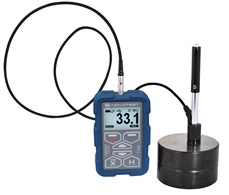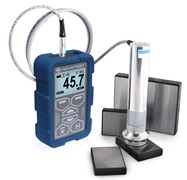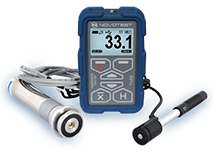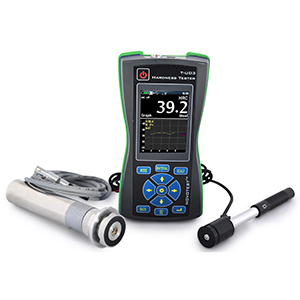How to choose the hardness tester?
Question №1. Bench or portable hardness tester?
 VS
VS 
There are two main types of hardness testers – bench (stationary,classical) and portable (mobile, electronic).
Bench hardness tester – is a classic hardness tester which is measuring the hardness by standard method of Brinell or Rockwell or Vickery or Shor and so on. As a rule, the name of the hardness tester includes the title of hardness scale. For example, “bench Brinell hardness tester” or “bench Rockwell hardness tester”. There are bench hardness testers that allow user to measure the hardness not only by one scale, but also by several hardness scales. For example, there are bench hardness tester which allows user to measured hardness by Rockwell, Brinell and Vickers scales. All Bench hardness testers are big and heavy (more than 50 kg), also these units should be installed on a table or floor. The main advantage of such devices – is implementation of the classic, direct method of measuring hardness.
Portable hardness testers – in contrast to the bench hardness testers, have small sizes, light weight and they are compact devices which measure the hardness by several hardness scales. Usually, the modern portable hardness testers can measure the hardness of all hardness scales. The advantage of portable hardness testers are allow users to take the device and get with it to the measuring samples. You needn’t take samples into the workshops. Portable hardness testers – is an electronic devices, so they usually have a set of useful features –user can save the results of measurements in the internal storage, after that the results can be transmitted to a computer for creating report of controlling in a specialized program ARM, which supplied with the portable hardness testers. Portable hardness testers – in contrast to the bench hardness testers, have a few advantages, but there are some cases, when they can be solved only by the bench hardness testers. However, such cases are very rare and we can say that in 99 cases out of 100, users can use portable device.
As a rule, the most useful and handy are portable devices. That’s why it is the best solution.
Question №2. Leeb, UCI or combined portable hardness tester?
Portable hardness testers can be divided into three types:
a) Leeb (dynamic, rebound, impact);
b) UCI (ultrasonic,contact-resonance, contact-impedance);
c) combined (UCI+Leeb).
 Leeb hardness testers are using the rebound method. The sensor of the device is installed on the sample. There is a peen in transducer (probe) of the device which hits the surface and after bounces off it. The device measures the speed of the peen before the impact and rebound speed after. The ratio of these speeds is multiplied by 1000 is called the number or Leeb hardness, by the name of the author who invented this method of measurement. Leeb hardness testers have one significant drawback, it is impossible to measure the hardness of samples that have weighing less than 5 kg, or thickness at the measurement place less than 10mm. In some cases, the hardness of these parts can be measured, grinding them to the massive slab through a layer of grease. But it is possible only in case if the shape of the sample allows to grind it.
Leeb hardness testers are using the rebound method. The sensor of the device is installed on the sample. There is a peen in transducer (probe) of the device which hits the surface and after bounces off it. The device measures the speed of the peen before the impact and rebound speed after. The ratio of these speeds is multiplied by 1000 is called the number or Leeb hardness, by the name of the author who invented this method of measurement. Leeb hardness testers have one significant drawback, it is impossible to measure the hardness of samples that have weighing less than 5 kg, or thickness at the measurement place less than 10mm. In some cases, the hardness of these parts can be measured, grinding them to the massive slab through a layer of grease. But it is possible only in case if the shape of the sample allows to grind it.
 UCI hardness testers are using the ultrasonic contact impedance method. For measuring the sensor is installed on the sample and user has just to press on it. At the end of the sensor there is a diamond pyramid, which is embedded into the surface of the object to not a large depth (about 50 microns). This hardness method is very similar to the classical Vickers method, but uses a micro load, such as 1 kg, 5 kg or 10 kg. In contrast to the Leeb hardness testers such devices has almost no restrictions for the weight and thickness of samples. The UCI probe is used for measuring of the hardness of small items, objects with a thin wall, complex shape, and to measure the hardness of surface hardened layers. But you can not use UCI probe for measuring the hardness of non-ferrous metals, cast iron, coarse-grained materials, massive products etc.
UCI hardness testers are using the ultrasonic contact impedance method. For measuring the sensor is installed on the sample and user has just to press on it. At the end of the sensor there is a diamond pyramid, which is embedded into the surface of the object to not a large depth (about 50 microns). This hardness method is very similar to the classical Vickers method, but uses a micro load, such as 1 kg, 5 kg or 10 kg. In contrast to the Leeb hardness testers such devices has almost no restrictions for the weight and thickness of samples. The UCI probe is used for measuring of the hardness of small items, objects with a thin wall, complex shape, and to measure the hardness of surface hardened layers. But you can not use UCI probe for measuring the hardness of non-ferrous metals, cast iron, coarse-grained materials, massive products etc.
 Combined portable hardness tester works with both (UCI (ultrasonic) and Leeb (dynamic)) probes. You will get the benefits of two methods of measurement – it is the maximum that can be obtained from portable hardness tester.
Combined portable hardness tester works with both (UCI (ultrasonic) and Leeb (dynamic)) probes. You will get the benefits of two methods of measurement – it is the maximum that can be obtained from portable hardness tester.
As for the price of devices, the Leeb hardness testers – are the most affordable, UCI – are a little more expensive. Combined hardness testers – are the most functional models, but, as a result they are also the most expensive.
So that, the second question is what is the method of measuring you need? If you are have enough financial opportunities, the best choice would be combined hardness tester. If your budget is limited you have to sacrifice functionality of the device and choose between UCI or Leeb hardness tester, considering the material and the dimensions of the mostly tested objects.
Question №3. The type and the method of measuring are have been chosen. How to choose the model of the device?
The model of portable hardness tester directly affects the usability of hardness tester. Depending on the chosen model of hardness tester, the functionality of the device can greatly different. So, the operating conditions of the instrument would be different. Choosing the model of hardness testers, consider the next functions: weight and size of the device; the size of the display and keyboard; ability to communicate with a PC; the ability to save the calibration settings, measurement results and other instrument settings; the ability to print the measurement results with the portable printer; ability to take photo of the measuring objects with reference to the measurement value at certain points on the testing object; and other.
The 2-nd model of the portable hardness tester has all the main technical capabilities, such as high accuracy of hardness measuring; basic hardness scales: Rockwell, Brinell and Vickers; ability to calibrate all scales + create custom scales of hardness; also it has the main essential operation functions, such as internal storage and communication with the PC; large bright display; extended operating temperature range of the device.
There are 3 portable hardness testers of 2-nd model:
1) Leeb Hardness Tester NOVOTEST T-D2
2) UCI Hardness Tester NOVOTEST T-U2
3) Combined Hardness Tester NOVOTEST T-UD2

The portable hardness testers of 2-nd model have all the main functions, like the best analogue of our competitors, but the price of our device is the lowest in the world among the all portable hardness testers with such functions set!
But, if user need a portable hardness tester with all modern operation functions, we can offer the 3-rd model of our portable hardness testers:
1) Leeb Hardness Tester NOVOTEST T-D3
2) UCI Hardness Tester NOVOTEST T-U3
3) Combined Hardness Tester NOVOTEST T-UD3
The 3-rd model device has the next advantages:
• Small imprint after measuring ( which is important mirror surfaces of shafts necks, blades, gear teeth, etc.);
• Measuring the hardness of the surface hardened layer;
• Wide range of hardness;
• Various measurement modes;
• 88 combinations of materials and hardness scales (calibrations);
• Calibration of any scale in any range;
• Convenience and ease of measurement;
• Optimized number of buttons;
• Large full color graphic display with bright back-lighting;
• Photo registering of measuring samples;
• Automatic recognition of probe;
• Type of connected probe indication;
• Calibrations stored in memory of probe;
• Extended temperature range (frost, down to – 40°C);
• Internal memory and connection with a PC;
• New, intuitive menu with tips on the buttons;
• Optional wireless mini printer;
• Water resistant case;
• Rubber bumper protected case;
• Internal clock;
• Hardness measurement of objects of any weight, with 1 mm wall thickness – inaccessible to the dynamic (Leeb) hardness testers (small parts, thin-walled structures, pipes, tanks, steel sheets, articles of complex shape, hardness control of metal coatings, etc.);
• The device has different operating modes:
Graph – the mode of building of graph
Histogram – the mode of building of histogram
Statistics – the mode of statistic
Smart – the mode of filtering of incorrect measurements
Signal – the mode of displaying of signal (only for Leeb probe)
The 3-rd model portable hardness testers is the most modern device in the word with the competitive price among the analogues.
So, we recommend the 3-rd model, because they has the most modern set of functions for a portable hardness testers in the world! So, if your budget is not constrained, the best choice would be the Combine Hardness Tester NOVOTEST T-UD3, but if the budget has some restrictions, we can confidently recommend the 2-nd model Portable hardness testers.
Hopefully this article would be help you to make the right choice of hardness tester!
If you have any questions, please contact us!
E-mail: sales@novotest.biz
Skype: novotest_world
Phone: +38 067 593 59 77


 +38 067 593 59 77
+38 067 593 59 77

